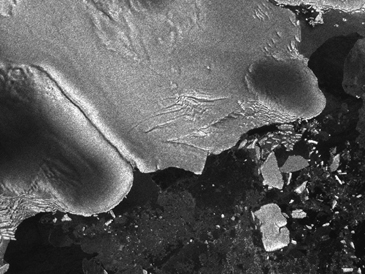The massive earthquake that shook Japan in March of 2011 created a tsunami that killed thousands. The tsunami was so powerful, in fact, that its effects were felt around the globe. When it reached Antarctica, it split an ice shelf that had been stable since at least 1965, creating two icebergs as big as islands.
 Photo of the Sulzberger Ice Shelf illustrating new icebergs breaking off after the Japan earthquake and resulting tsunami that occurred on March 11, 2011. Credit: NASA
Photo of the Sulzberger Ice Shelf illustrating new icebergs breaking off after the Japan earthquake and resulting tsunami that occurred on March 11, 2011. Credit: NASAFor decades, scientists had suspected that tsunamis could trigger the birth of icebergs, but they lacked enough evidence to confirm the idea. So when the Japanese quake hit, a team of researchers calculated when its ripples should reach Antarctica -- 8,000 miles away. They then used satellites to keep an eye on Antarctic ice shelves -- large, thick sheets of ice that extend from the land onto water.
They expected the tsunami to hit Antarctica about 18 hours after the earthquake -- after traveling about 8,000 miles. The tsunami waves were only about a foot high, but they were relentless, transferring a lot of energy onto the coastline. It happened at the end of the Antarctic summer, when there wasn’t a lot of sea ice to absorb the waves’ energy.
Within 30 hours of the tsunami, a ’berg as big as Manhattan Island broke off the Sulzberger Ice Shelf, which faces New Zealand, near the Ross Sea. A second large iceberg broke off just 24 hours later, along with several smaller ones.
The sequence seems to confirm that tsunamis can indeed help give birth to icebergs -- once again demonstrating the vast and global power of the seas.

